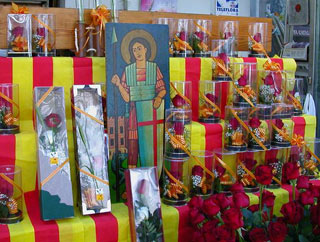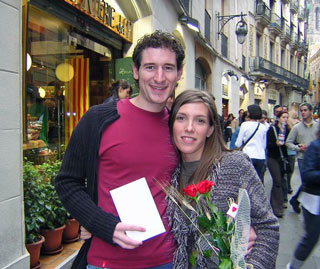Human Flower Project
Monday, April 23, 2007
Sant Jordi: Double Whammy
Catalonia’s patron saint, honored April 23, adds a literary layer to Valentine’s romance.

Roses packaged for sale, April 23, 2004
with Catalonia’s patron Sant Jordi, Barcelona, Spain
Photo: Jenny Edwards
Consumption is the new piety. Would-be saints won’t be caught dead drinking the wrong kind of coffee, wearing a pelt, or driving a full-size automobile. While the era of indulgences may be over, sanctimonious indulgence has filled the void.
In Barcelona today, and in other parts of Catalonia, local patron Sant Jordi (known elsewhere as St. George) receives his due primarily through a tit-for-tat tradition of gifts. Men shop for roses, giving them to their ladies a la Valentine’s Day, and women reciprocate by buying their fellows books. Las Ramblas, one of the liveliest promenades in the world on just an ordinary day, becomes a puzzle of bookracks and flower pails. Wait till U.S. marketers realize that, had they only settled on a different holiday for lovers, they’d be doubling their sales.
We think of St. George astride a horse, plunging his lance down the throat of a dragon (How dull of us not to have seen this as foreplay!). Though the original St. George was likely born in current day Turkey, the Catalans transposed his story to the local town of Montblanc. According to legend a stinky lizard threatened the city and could only be kept at bay with daily human sacrifices. Eventually, the local princess was to take her turn at martyrdom, but before she was eaten, chivalrous George appeared and slew the beast.
 A book for you, a rose for me (Kev and Nate)
A book for you, a rose for me (Kev and Nate)
Diada de Sant Jordi
in Barcelona
Photo: Borderline/Cruzando Fronteras
What does all this have to do with shopping and exchanging gifts? Well, a rosebush was said to have “sprouted from the dragon’s blood,” and not missing a beat, Sant Jordi “plucked the prettiest blossom for the princess.” One source claims the giving of roses on April 23 has been going on “since the Middle Ages to honor chivalry and romantic love,” though we’ve not been able to find any early reference to the custom. Nor have we seen art historical renderings of Saint George with a rose, or a princess, for that matter. We had, honestly, considered him more a super-exterminator than a lover. And books? “In 1923, the lovers’ fest merged with International Book Day to mark the anniversary of the all-but-simultaneous April 23, 1616 deaths of Miguel de Cervantes and William Shakespeare.”
We welcome further insight into the history of this intriguing biblio-floral tradition. What could be more delightful than a gift-swap of roses and books? It’s our guess that new life flowed into Diada de Sant Jordi thanks to the combined forces of Catalan nationalism and savvy marketing. Either one is a good match for a dragon.
Culture & Society • Cut-Flower Trade • Religious Rituals • Secular Customs • Permalink




